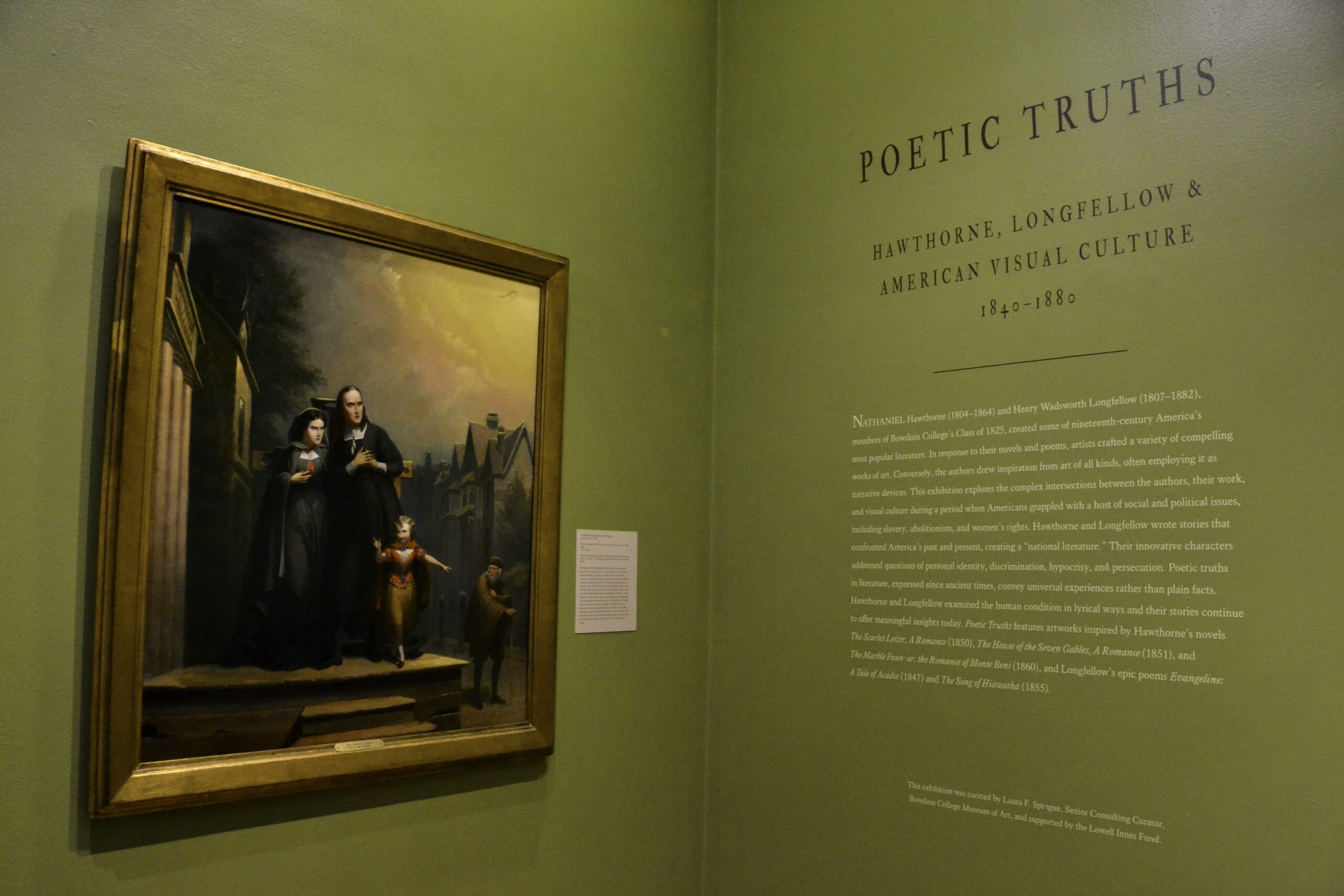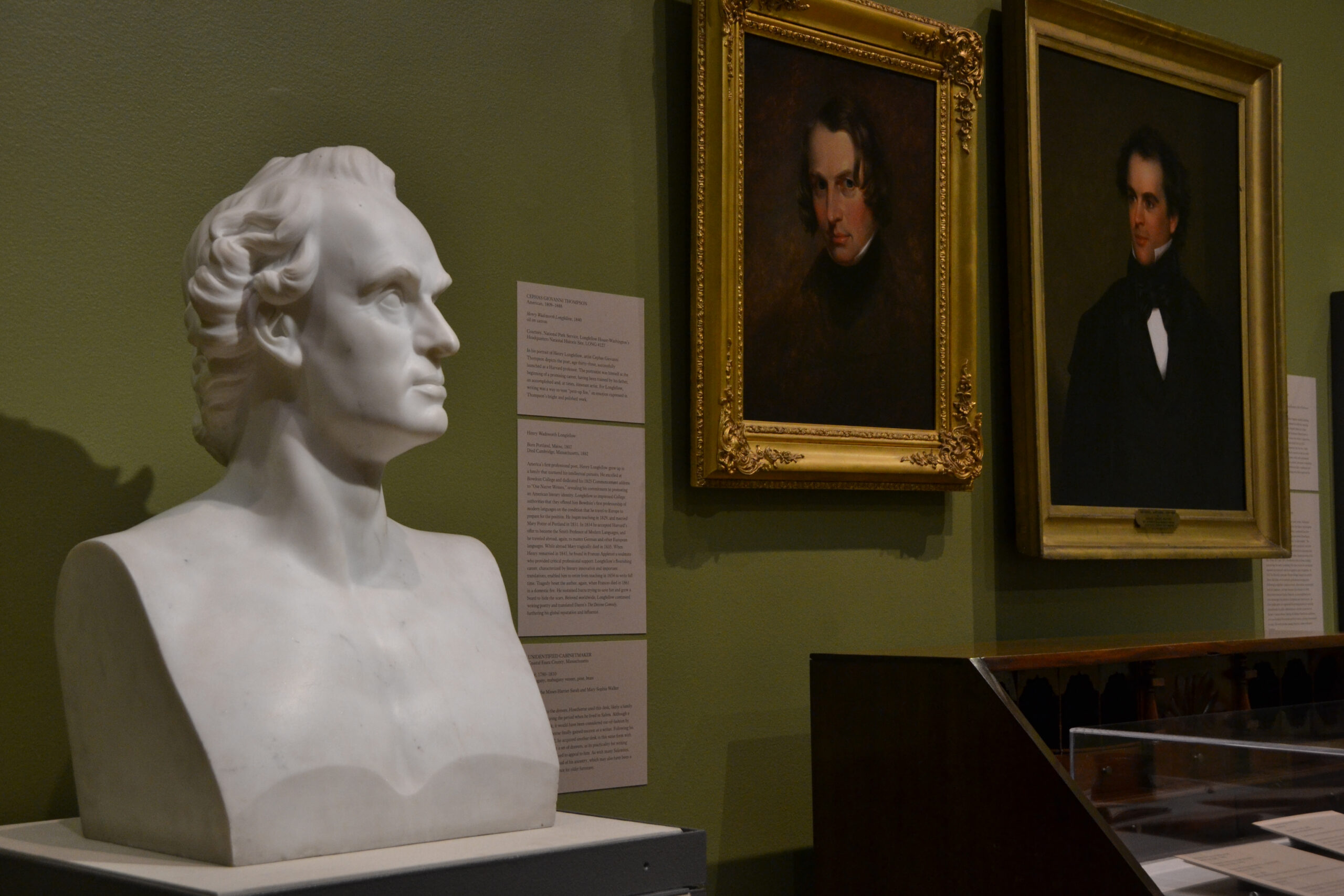BCMA and Special Collections join annual Longfellow Days celebration with exhibits
February 21, 2025
On February 6, the Bowdoin College Museum of Art (BCMA) opened “Poetic Truths: Hawthorne, Longfellow and American Visual Culture, 1840-1880,” an exhibition focused on Bowdoin alumni Henry Wadsworth Longfellow and Nathaniel Hawthorne and their influence on the arts. This exhibition, in conjunction with the Department of Special Collections & Archives’ “Bowdoin College Class of 1825” digital archive and exhibition, celebrates 200 years since these alumni graduated.
Laura F. Sprague, the senior consulting curator at the BCMA, focused “Poetic Truths” on the artistic influence of these writers during their lifetimes, from their time at the College to Longfellow’s later escapades in Rome and Essex.
“It’s really interesting because the museum owns portraits of Hawthorne and Longfellow, but they were posthumously painted, and they’re really late in the 19th century,” Sprague said. “They really didn’t reflect the vibrancy and brilliance of their writing and their careers during their lifetime.”
The BCMA exhibition also features a range of pieces, including the desk Hawthorne used while he was in Salem, daguerreotypes of Longfellow and a sculpture of Longfellow by Edmonia Lewis. Lewis was an Afro-Indigenous artist that worked in Rome that was particularly inspired by Longfellow’s “Song of Hiawatha.”
Casey Braun, the curator of the BCMA, found that the diversity of artists and pieces depicted in “Poetic Truths” complicates and deepens the representations of both alumni, connecting their work to modern themes.
“It can be really easy to see a lot of these early 19th-century men and white male figures as being kind of very irrelevant to our own time,” Braun said. “But in a lot of ways, the themes that they were grappling with in their writing are still relevant today.… They were addressing issues of race and sovereignty with respect to both enslaved individuals as well as indigenous populations.… We’re thinking about these histories and these topics 200 years later.”
The BCMA also hosted a lecture by Nicholas Basbanes on February 7 centered on the artistic influence of Sophia Peabody and Fanny Appleton, Hawthorne’s and Longfellow’s wives, respectively. Sprague saw the lecture as another lens through which these authors’ works could be interpreted.
“I think that there’s so much to learn about these people, and I think that the writing of these men is still relevant today,” Sprague said. “They’re talking about big social issues like persecution and wrongful conviction [and] hypocrisy. It’s all around us today, so [there’s] just the way of looking at another period in American history and asking, ‘How did people address those kinds of ideas?’”
The Special Collections exhibition, curated by Director of Special Collections & Archives Kat Stefko, in contrast, takes a more Bowdoin-centric approach to documenting the Class of 1825.
“This exhibit was sparked by my desire to know what the Class of 1825 was really like when they were at Bowdoin.… The friendships that the Class of 1825 cultivated during their four years at Bowdoin profoundly influenced their lives,” Stefko wrote in an email to the Orient.
The exhibitions, as well as the events they portray, were included in the overall program of Longfellow Days, an annual month-long celebration of Longfellow’s birthday and influence throughout February. While much of the celebration normally takes place in off-campus Brunswick spaces, such as the Curtis Memorial Library and the Unitarian Universalist Church, these exhibitions tie the celebration to Bowdoin’s campus as well. Braun hopes that this connection can serve as a point of convergence for both students and community members to engage with the history and art of the College.
“I think the arts are one of the most accessible ways to get into conversation with people,” Braun said. “There’s something that can be democratizing about it, and it can offer these points of access that [you] don’t necessarily have to come to with a shared vocabulary.”
For Anne Goodyear, the co-director of the BCMA, not only does the exhibit connect the arts of the past with the themes of the present, but it also provides a gateway through which she thinks of how future generations of students will also be defined by their time at the College.
“I love thinking about the ways in which their experience as students in Bowdoin was forming the intellectual curiosity that would in turn define them,” Goodyear said. “It is a reminder to me of the tremendous energy on our campus and the many ways in which the education, the conversations, the fun activities with which we are all involved [with] on our small little campus can continue to change the world and continue to influence the way in which we see and understand [the world].”



Comments
Before submitting a comment, please review our comment policy. Some key points from the policy: